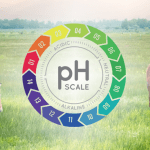Wireless Device That Measures Gastric pH May Help Treat EGUS

Small, peanut-sized wireless devices fixed to the inner lining of a horse’s stomach can transmit real-time pH measurements of the gastric environment. Being able to continuously measure the pH of the stomach contents will help improve treatment strategies for horses with equine gastric ulcer syndrome (EGUS).
Ulcers can develop in either the glandular (lower) or squamous (upper) region of the stomach, and many horses have both types of ulcers simultaneously. While glandular and squamous disease both fall under the umbrella term EGUS, they are two distinct disease processes with unique risk factors and causes.
“The mainstay of treating either type of ulcer is acid suppression to increase the pH of the stomach. However, acid suppression can be less effective for glandular ulcers compared to squamous ulcers. We are still learning about what causes glandular ulcers and the best ways of treating them,” said Ashley Fowler, Ph.D., a Kentucky Equine Research nutritionist.
Omeprazole is a proton-pump inhibitor that blocks the production of hydrochloric acid in the stomach. The rationale is simple: a less acidic pH of the stomach causes less damage to the lining of the stomach. Typically, horses are treated with omeprazole once daily for 28 days.
One phenomenon occurring upon cessation of omeprazole is “rebound hyperacidity,” where there is a temporary decrease in pH, resulting in a more acidic stomach.
“This phenomenon may result in new ulcers forming quickly after discontinuing omeprazole, making it seem the horse failed to respond to treatment,” explained Fowler.
Being able to measure intragastric pH will permit veterinarians to better understand EGUS, particularly glandular disease, and optimize treatment protocols to avoid treatment failures and disease recurrence.
Currently, methods of continuous measurement of gastric pH in horses are either impractical or ineffective. In human medicine, however, small capsules temporarily attached to the inner wall of the stomach are now used to wirelessly transmit gastric pH data for analysis. These devices are approximately the size of a shelled peanut.
To determine if these capsules could be used in horses, veterinary researchers surgically “clipped” the devices to the stomach lining via gastroscopy.* In total, 11 squamous and seven glandular capsules were successfully placed in 11 healthy horses. The capsules transmitted pH data every six seconds until time of capsule detachment, which ranged from six to 158 hours. Just over half of all capsules lasted 24 hours or longer, and squamous capsules remained attached longer than glandular capsules.
The mean pH values of the squamous and glandular regions were 4.9 and 3.0, respectively, with the lower numbers indicating more acidity of the stomach. Changes in pH after feeding and natural variation over time were noted in the squamous but not the glandular regions of the stomach.
Capsule attachment was well tolerated by all horses.
“This novel technique enabled the continuous wireless measurement of intragastric pH at known locations in the equine stomach under fed and fasted conditions, offering a valuable alternative model for pharmacodynamic studies and potential for clinical use,” concluded the research team.
Having a better understanding of EGUS will improve our ability to treat this disease, which affects up to 100% of horses in certain populations. EGUS affects performance, overall health, and quality of life and therefore needs to be addressed.
“In addition to omeprazole, changes to management are important. For example, providing continuous access to forage helps reduce the risk of ulcers, especially if forage is consumed before exercise. The fibrous mat in the stomach helps reduce splashing of acid onto the squamous portion of the stomach while the horse is exercising,” explained Fowler.
Adding gamma-linoleic acid (GLA), a fatty acid found in ReSolvin EQ, can also help support the ulcer healing process. A recent study found that horses fed a blend of GLA with the omega-3 fatty acids EPA and DHA had reduced squamous ulcer severity compared to control horses.**
*Hodgson, E., M. Thirouin, P. Narayanan, T.-R. Romano, J. Wise, and S. Bond. 2025. A novel placement method of a calibration-free pH capsule for continuous wireless measurement of intragastric pH in horses. Journal of Veterinary Internal Medicine 39(1):e17273.
**Pagan, J.D., A.A. Hauss, E.C. Pagan, J.L. Simons, and B.M. Waldridge. 2022. Long-chain polyunsaturated fatty acid supplementation increases levels in red blood cells and reduces the prevalence and severity of squamous gastric ulcers in exercised Thoroughbreds. Journal of the American Veterinary Medical Association 260(S3):S121-S128.








